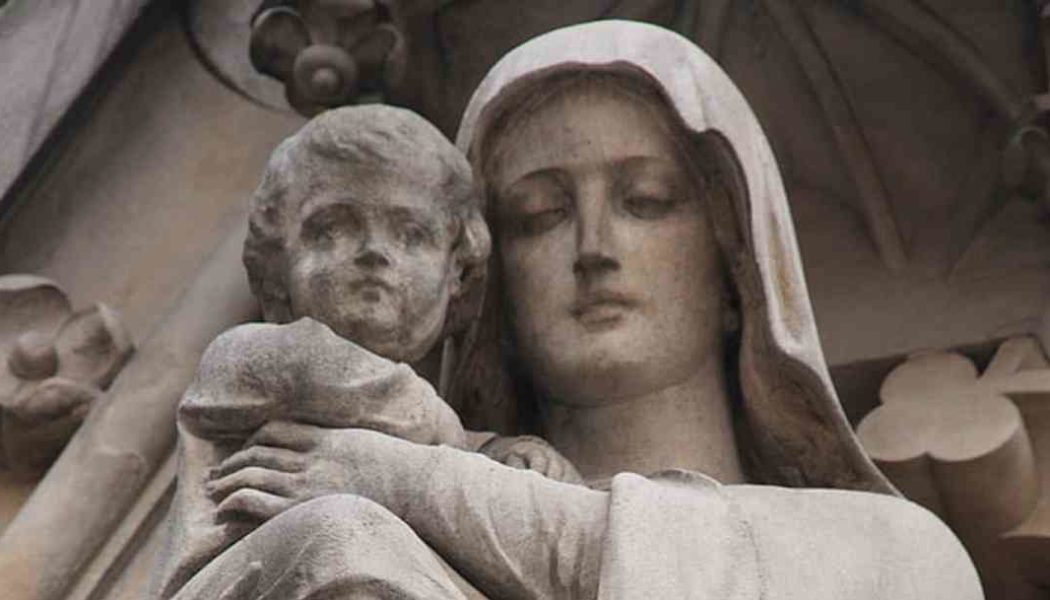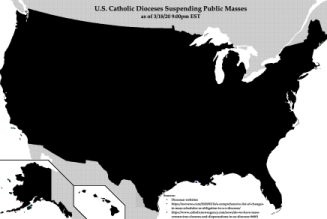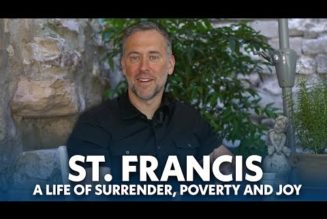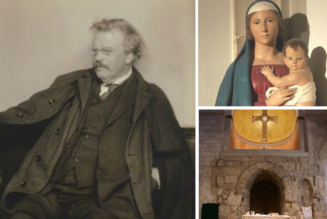
Jesus is angry in the Gospel for the 31st Sunday of Ordinary Time, Year A, but he’s not in a rage. In fact, his anger is practically maternal.
This Sunday’s Gospel is part of a full-chapter-long list of woes Jesus pronounces against the Pharisees. But if we picture him spitting out words with disgust and revulsion, we’re wrong.
Put his words in context to see it.
Consider not just what he says, but who he’s talking to, what he just finished saying, and what he’ll say next.
What does he say? He complains that the Pharisees “tie up heavy burdens hard to carry and lay them on people’s shoulders but they will not lift a finger to move them,” then gets even more intense as his words continue. “Woe to you, scribes and Pharisees, you hypocrites,” he says, and calls them “blind fools,” “whitewashed tombs,” “serpents,” and a “brood of vipers,” demanding, “How can you flee from the judgment of Gehenna?”
Who is he talking to? The Gospel tells us at the very beginning. “Jesus spoke to the crowds and to his disciples,” it says. He’s not telling off the Pharisees — he’s warning the crowds about the Pharisees. He tells the people to observe what they say, because they have real authority, but not to follow their example. Then he goes on to spell out what about their example he wants them to avoid.
What did he just finish saying? We heard that in previous Sundays: Various Jewish leaders have been approaching him, trying to trip him up — posing questions that are meant not to benefit them but to damage him. And, one by one, he has shown them the truth. He answered their question about taxes, the Resurrection, and the commandments in ways that have changed history — but ways that didn’t change the scribes and Pharisees at all.
As for what he’ll say next — at the end of his condemnation of the Pharisees, Jesus reveals the sadness beneath his anger. He says “Jerusalem, Jerusalem, you who kill the prophets and stone those sent to you, how many times I yearned to gather your children together, as a hen gathers her young under her wings, but you were unwilling!”
This puts his anger in perspective. It isn’t an unreasonable rage — it’s a refusal to have “unreasonable patience” as St. Thomas Aquinas distinguishes when he speaks about sinful and righteous anger. When the Son of God gives you the greatest answers to the deepest questions of humankind, and you answer with threats, true compassion will give you severe condemnation, not acceptance and tolerance.
Jesus is showing the proper kind of anger which is meant “to correct vices,” not the improper kind that “desires vengeance,” to quote Aquinas (and the Catechism) on anger again.
But it’s even more telling to compare Jesus’s critique of the Pharisees with the Two Greatest Commandments he gave last Sunday.
“You shall love the Lord, your God, with all your heart, with all your soul, and with all your mind,” and “You shall love your neighbor as yourself,” he says.
As for love of God: The Pharisees wore phylacteries on their heads and left arms indicating love of God with their minds and hearts. These ones widened theirs to make the outward show of love bigger, while their actual love grew smaller in the face of Christ himself. They also wore tassels to show their commitment to the commandments — loving God with all their soul. But they increased the length of their tassels instead of increasing their fidelity to the living God.
As for love of neighbors: They give their followers “burdens hard to carry” but “will not lift a finger to move them” — the very opposite of loving your neighbor as yourself.
But the Gospel isn’t here to give us as a way to critique the Pharisees. It is here to give us a way to critique ourselves.
If we’re honest, we will all see ourselves in the Pharisees.
I, too, like it when I look holier than I am, and I, too, judge others more intensely than I serve others. But if you read all of the readings this week, you can also begin to see a remedy: The way to avoid being a Pharisaical church is to become a Marian Church.
Jesus spoke of a maternal church in the words quoted above, imagining his body as a mother hen. But St. Ambrose (340-397 A.D.) noted that the Church, like Mary, “conceived us by the Holy Spirit and, as a virgin, gave birth to us without pain.” The Vatican II document Lumen Gentium says the same thing calling the Church a mother, like Mary, who “brings forth to a new and immortal life the sons who are born to her in baptism, conceived of the Holy Spirit and born of God.”
You can see just how deep this goes by comparing St. Louis de Montfort’s 10 virtues of Mary to the Pharisees in Sunday’s readings.
The Pharisees have teaching authority, but no faith in Jesus. Mary has no authority, but a lively faith.
The Pharisees preach but do not practice. Mary has total obedience.
The Pharisees burden people. Mary suffers for people with universal mortification.
The Pharisees widen their phylacteries and tassels to look holy. Mary has divine purity.
The Pharisees love places of honor. Mary has profound humility.
The Pharisees want to be called Rabbi, teacher. She is not called a teacher, but she has divine wisdom.
The Pharisees need to learn that “The greatest among you must be your servant.” Mary has ardent charity.
St. Paul was a Pharisees who understood the Marian Church. The Second Reading is from his First Letter to the Thessalonians, which is perhaps the oldest book in the New Testament. In it, he says:
“We were gentle among you, as a nursing mother cares for her children. With such affection for you, we were determined to share with you not only the gospel of God, but our very selves as well, so dearly beloved had you become to us … recall our toil and drudgery, working night and day.”
That fills out the last three virtues of Mary: angelic sweetness, heroic patience, and continual prayer.
At each Mass on Sunday, the People of God meet Mother Church, nourishing her children.
Fist, she forms us with the Liturgy of the Word. Then, we come forward to receive the body and blood of Jesus Christ, uniting us with him and drawing us into his family.
The condemnation of the scribes and Pharisees comes in between Jesus’s final triumphal entry into Jerusalem and his passion and death on the cross. After he calls out the faults of the Pharisees, Jesus plans to take their burden onto himself and die for them.
That’s also the way we should take the lessons at Mass. Jesus corrects us lovingly, then recapitulates his sacrifice on the altar, and then invites us to come forward so he can share our burden.
Isn’t that the way good mothers chastise? They show us who we could be, point out where we fall short, and then do everything in their power to help us get there. And after all of that, they feed us.
This Sunday, after returning to the pew, give thanks to Our Lord and Mother Church for the communion that configures us to Christ. Use the words of this Sunday’s Psalm:
“I have stilled and quieted my soul like a weaned child. Like a weaned child on its mother’s lap, so is my soul within me. In you, Lord, I have found my peace.”
Image: PickPik.




![This guy threw out a hard drive containing $384 million of Bitcoin. Now he’s fighting to dig up the landfill [language warning]…](https://salvationprosperity.net/wp-content/uploads/2021/12/this-guy-threw-out-a-hard-drive-containing-384-million-of-bitcoin-now-hes-fighting-to-dig-up-the-landfill-language-warning-327x219.jpg)



